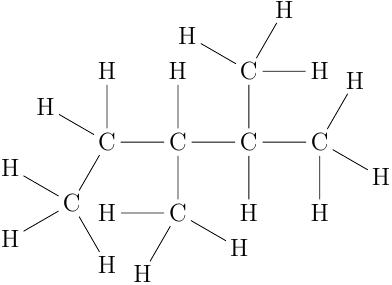Sheet 5
Task 1 (Wiener index and boiling points)
Given the following graph $G$ representing the chemical compound 2,3-dimethylpentan:

-
Determine the edge-weight matrix of the graph of the carbon backbone.
-
Determine the distance matrix.
-
Determine the Wiener-Index.
-
Determine the number of shortest paths of length 3.
-
Determine the value $p_0$ and $w_0$ of the formula for predicting the boiling point for this compound.
-
Determine the estimated boiling points and compare it to the real boiling point.
-
What is the asymptotic worst case performance for finding the distance matrix based on repeated squaring?
-
Do you know a method that has a better asymptotic worst case performance?
Task 2 (From random polygon to an ellipse)
Given the matrices \(M_3 = \frac{1}{2}\left(\begin{array}{ccc} 1 & 1 & 0\\ 0 & 1 & 1\\ 1 & 0 & 1 \end{array}\right)\) and \(M_4 = \frac{1}{2}\left(\begin{array}{cccc} 1 & 1 & 0 & 0 \\ 0 & 1 & 1 & 0 \\ 0 & 0 & 1 & 1 \\ 1 & 0 & 0 & 1 \end{array}\right)\)
-
How do these matrices relate to the lecture “From Random Polygon to Ellipse”?
-
Which of these matrices is invertible?
-
Compute the determinant of $M_3$ and $M_4$.
-
Are the columns of $M_3$ independent? Are the columns of $M_4$ independent?
-
If $A$ is a triangular matrix, i.e. $a_{ij}=0$, whenever $i>j$ or, alternatively, whenever $i<j$, then its determinant equals the product of the diagonal entries.
Use this fact is order to prove for all values of $k\geq 3$ if the matrix $M_k$ is invertible or is not invertible.
-
Draw an equilateral triangle with points $(x_1^k, y_1^k)$, $(x_2^k, y_2^k)$, and $(x_3^k, y_3^k)$. Assume the triangle is a result of $M_3\cdot x^{k-1}$ and $M_3\cdot y^{k-1}$ as presented in the lecture. Ignoring normalization, find $x^{k-1}$ and $y^{k-1}$. Can you find several solutions for $x^{k-1}$ and $y^{k-1}$?
-
Draw a square with points $(x_1^k, y_1^k)$, $(x_2^k, y_2^k)$, $(x_3^k, y_3^k)$, and $(x_4^k, y_4^k)$ . Assume the square is a result of $M_4\cdot x^{k-1}$ and $M_4\cdot y^{k-1}$ as presented in the lecture. Ignoring normalization, find $x^{k-1}$ and $y^{k-1}$. Can you find several solutions for $x^{k-1}$ and $y^{k-1}$? What is the conclusion wrt. the (non-)existence of an inverse of $M_4$?
Task 3 (From random polygon to an ellipse)
Given vector $v=(v_1, \ldots, v_5) = (0,3,-1,11,-3)$.
-
Determine $w=v-\overline{v}$, where $\overline{v}$ is a vector where each entry is the mean of all values $v_i$.
-
Determine $\frac{w}{||w||_2}$, where $||\cdot||_2$ refers to the 2-norm.
-
What is the length of vector $\frac{w}{|| w ||_2}$?
Task 4 (From random polygon to an ellipse)
-
Use python to compute 0.1 + 0.2. See
https://docs.python.org/3/tutorial/floatingpoint.html for an introduction to understand the results your observe. -
Study the three examples of python code reported below. Essentially, in all three examples a function $f$ is applied $c$ times, and then $f^{-1}$ is applied $c$ times.
a. Which result is expected mathematically?
b. Without running the code: which of the three examples might suffer from numerical issues “most”?
c. Without running the code: for which values of $c$ do you expect to see numerical issues?
d. Why is this related to the lecture “From Random Polygon to Ellipse”?
#Example 1
for c in range(2000):
a=1.0
for i in range(c):
a=a/2
for i in range(c):
a=a*2
print(c,a)
#Example 2
for c in range(2000):
a=1.0
for i in range(c):
a=a/2+1.0
for i in range(c):
a=(a-1.0)*2
print(c,a)
#Example 3
for c in range(2000):
a=1.0
for i in range(c):
a=a/2+10000.0
for i in range(c):
a=(a-10000.0)*2
print(c,a)